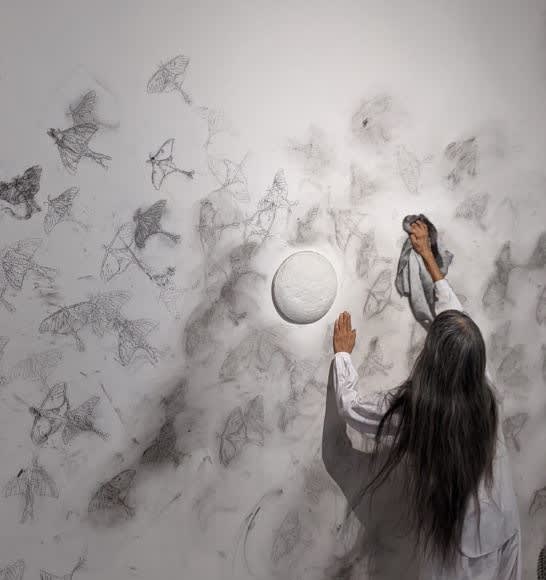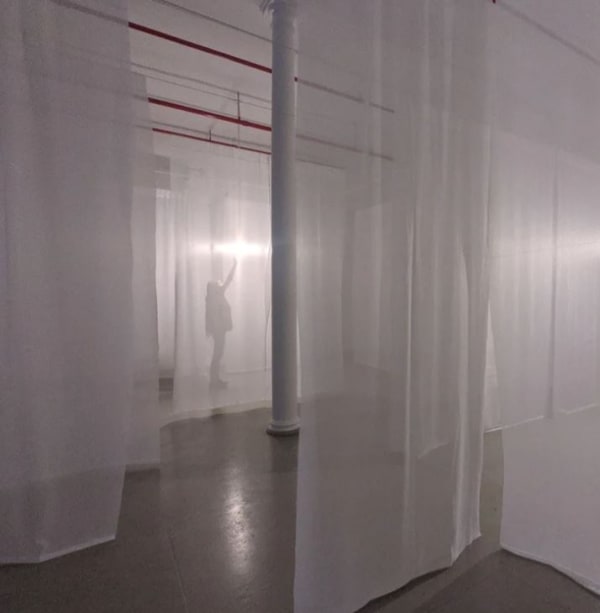WESTWOOD GALLERY NYC presents Drawn to the Light, a site-specific installation by New York–based artist Nobuho Nagasawa—her first solo exhibition with the gallery. Rooted in a transdisciplinary practice that fuses technology, sound, and community engagement, Nagasawa transforms the gallery into an ephemeral cityscape honoring cycles of life, memory, and renewal.
The installation unfolds across three symbolic spaces inspired by nearby Tompkins Square, Washington Square, and Columbus Park, where the artist gathered oral histories of loss and resilience. Each space features a single light source—emitting voices of memory—toward which hundreds of luna moths, hand-stenciled by Nagasawa over the course of the exhibition, are drawn. The luna moth, a fleeting and mythical creature, becomes both symbol and metaphor for spirit, transformation, and the urgency of living fully. On the exhibition’s final day, the artist erased the moths in a performative act of release, honoring lives lost during the Covid-19 pandemic.
Referencing the Japanese Obon festival, Drawn to the Light extends rituals of remembrance into an immersive environment of light, sound, and communal reflection—an elegiac space where healing begins through shared memory.
-
 Nobuho Nagasawa: Drawn to the Light | Installation View
Nobuho Nagasawa: Drawn to the Light | Installation View -
 Nobuho Nagasawa: Drawn to the Light | Installation View
Nobuho Nagasawa: Drawn to the Light | Installation View -
 Nobuho Nagasawa: Drawn to the Light | Installation View
Nobuho Nagasawa: Drawn to the Light | Installation View -
 Nobuho Nagasawa: Drawn to the Light | Installation View
Nobuho Nagasawa: Drawn to the Light | Installation View -
 Nobuho Nagasawa: Drawn to the Light | Installation View
Nobuho Nagasawa: Drawn to the Light | Installation View -
 Nobuho Nagasawa: Drawn to the Light | Installation View
Nobuho Nagasawa: Drawn to the Light | Installation View -
 Nobuho Nagasawa: Drawn to the Light | Installation View
Nobuho Nagasawa: Drawn to the Light | Installation View -
 Nobuho Nagasawa: Drawn to the Light | Installation View
Nobuho Nagasawa: Drawn to the Light | Installation View
WESTWOOD GALLERY NYC presented a solo exhibition by New York based installation artist Nobuho Nagasawa. This was her first solo show with the gallery and included an all-encompassing, site-specific installation entitled Drawn to the Light, which combines the artist’s deep-rooted tradition of multidisciplinary art, fusing technology, light, sound, and healing through community engagement.
The gallery installation turned the space into an ephemeral city to honor the cycle of life through symbolisms from nature. Prior to the exhibition, Nagasawa recorded stories from individuals in three public spaces, Tompkins Square, Washington Square, and Columbus Park. The three parks triangulate an area in which WESTWOOD GALLERY NYC is located, in the center of the Bowery community. Visitors can walk through the gallery as an ethereal experience with white scrim panels hanging from the ceiling and marking off three contextual spaces related to each park. Each of these three areas will have a single light source, to which the symbolic luna moths are drawn to; and the light will emanate the oral stories of loss.
On a 35-foot gallery wall with sculptures of the moon, Nagasawa stenciled hundreds of luna moths over the course of the exhibition, marking a visual memory which connects to emotional memory. The luna moth, a mythical symbol in many cultures, represents the inner spirit, intuition, awareness, and trust in ourselves. After 12 months in metamorphosis, the luna moth exists for less than 10 days as a winged adult and is rarely seen due to its nocturnal nature. Their short life span reminds us of our moments to live and love to the fullest. On the final day of the exhibition, Nagasawa erased the moths as a symbolic act of release for all we have lost during Covid-19.
The Drawn to the Light installation also references the 500-year tradition of Japan’s Obon, a summer festival to commemorate ancestors. On the last day of Obon, candle-lit lanterns are released into rivers to guide the spirits of ancestors back to the other world. Following this tradition, Nagasawa’s installation in the gallery is a two-month extension of the three-day Obon festival, which ends according to the lunar calendar on August 16th. The three light and sound environments capture the same spiritual qualities of the Bon-chochin, releasing many stories in remembrance of the spirit of precious lives lost.
Nagasawa works in unconventional environments, often outside the mainstream art world and gallery settings. She revitalized a destroyed synagogue site in Berlin, transformed abandoned World War II bunkers into motels for lovers, adapted a Turkish penitentiary into a sonic environment, created a tribute to the lost knowledge at the Alexandria Library in Egypt and flew kites with the local community in Fukushima after the nuclear disaster. Her works invite audience participation and community collaboration to reveal and address wounds from the past and give dignity to the healing process by juxtaposing the weight of dark history with resilient and revitalizing poetic gestures.
Site Interviews: Nobuho Nagasawa collaboration with John Stephen Ellis, AIA
Soundworks: Jon Sakata











